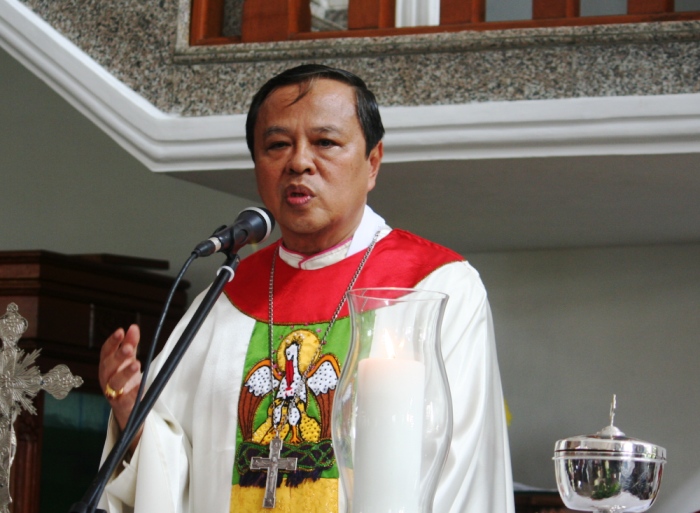
DARI situs resmi Vatikan, kami kutipkan presentasi Mgr.Suharyo yang mengesankan ini.
Pada presentasi ini, nama dan jabatan resmi Mgr.Suharyo juga disebut, yaitu : H. Exc. Rev. Mons. Ignatius Suharyo Hardjoatmodjo, Archbishop of Jakarta, Military Ordinary for Indonesia.
I would like to share with you a simple experience I had during my visit to a parish where I met a local catechist.
I asked him, “How many catechumens do you have?”.
I was surprised to hear that he had more than ninety catechumens. It was quite a lot. I asked him further, “Have you ever asked your catechumens why they wish to be baptized into the Catholic Church?”.
He answered, “Many of them said that they were touched by the way Catholics pray during public events such as wedding feasts or funeral services”.
The prayers are so touching to their hearts, because in those occasions the invocations and benedictions are delivered in their vernacular mother tongue so that they readily understand the content, whereas before they usually heard prayers recited in a foreign language, as Muslims pray in Arabic.
The Church’s evangelizing activity is – as we all understand – an act of communication which entails two basic components, namely the communication content or message – God’s revelation and faith in Jesus Christ – and the communication medium – means and language within a faith community context.
As far as language is concerned, translating one liturgical text to another – and any text for that matter, often prompts us to face delicate challenges or even problems. There is on the one hand, the demand for literal translation. On the other hand, we all understand that literal translation is not always possible, because of the diversity and complexity of languages.
For example when the priest addresses the people, “Dominus vobiscum”, and the people are to reply “Et cum spiritu tuo”. The word “spiritus” as translated into “roh” in our language could readily evoke the idea of “evil spirit”, thus “et cum spiritu tuo” means for some communities “with your evil spirit”.
My wish – I hope that I am not alone – is that the translation of liturgical text ought not always to be done literally, rather seriously take into account the diversity of the cultural background.
Could the principle of subsidiarity be applied in the task of translation and even in other areas of the life of the local Church? – Subsidiarity being the spirit of Vatican II.
In this way we keep our “fidelity both to the message whose servants we are and to the people to whom we must transmit it”, (EN 4), particularly with respect to the young who live in a mass-media culture, the Church must strive to convey her message in a language that touches their hearts.
In this way, the local Church will become more communicative and expressive and as a result the faith of the people will be more energized and more relevant to their Catholic lives and engagement both in the Church and in the world.
Prinsip subsidiaritas
Kisah salam “dominus vobiscum” yang bikin aula Sinode meledak dalam tawa terpingkal-pingkal, boleh jadi akan jadi anekdot sinode sepanjang masa. Ini juga bukan sekedar masalah terjemahan “et cum spiritu tuo”, yang di Indonesia bisa ditafsirkan sebagai “dan bersama roh (jahat) mu”.
Kisah kecil yang diangkat Mgr.Suharyo di aula Sinode itu mewakili “kisah besar” “tegangan” antara “pusat” dan “daerah”, antara “Gereja Roma Katolik di Indonesia” dan “Gereja Roma Katolik Indonesia”!
Saya yakin, Mgr. Suharyo faham betul dengan masalah “inkulturasi” ini. Dengan tepat, Uskup Agung Jakarta ini mengajak para peserta Sinode melihat akar masalahnya, yaitu prinsip “subsidiaritas”.
Istilah “subsidiaritas” memang jarang kita pakai dalam pergaulan sehari-hari. Ini istilah filsafat sosial.
Kamus Inggris “Oxford Dictionary” menerangkan istilah subsidiaritas (“subsidiarity” dalam bahasa Inggris), mengikuti kata Jerman subsidiarität. Istilah subsidiarität ini dikenal di Jerman sejak tahun 1809 dan dipakai sebagai istilah hukum.
Kata ini menjadi sangat populer, setelah pada tahun 1931 Paus Pius XI menerbitkan Quadragesimo Anno. Ensiklik yang berisi ajaran sosial gereja ini, sangat disambut di Jerman dan diterjemahkan dalam bahasa Jerman. Istilah ini ditemukan pada §80 Rundschreiben über die gesellschaftliche Ordnung, versi bahasa Jerman dari Ensiklik Quadragesimo Anno yang bersejarah ini.
Sejak saat itu, di Barat istilah “subsidiaritas” lebih disangkutkan dengan ajaran sosial Gereja dibanding dengan istilah legal sosial biasa.
Masih menurut The Oxford English Dictionary, subsidiaritas berasal dari kata Latin subsidio, yang artinya bantuan atau pertolongan.
Dalam konteks ajaran sosial kemasyarakatan khususnya ajaran sosial Gereja, subsidiaritas adalah “an organizing principle stating that a matter ought to be handled by the smallest, lowest, or least centralized authority capable of addressing that matter effectively. Defines subsidiarity as the idea that a central authority should have a subsidiary function, performing only those tasks which cannot be performed effectively at a more immediate or local level“ (Bersambung)
Photo credit: Uskup Agung Jakarta Mgr. Ignatius Suharyo Pr (Mathias Hariyadi)
Artikel terkait:
- Pijar Vatikan II di Tahun Iman: Mgr. Suharyo Menggemparkan Vatikan (12A)
- Pijar Vatikan II di Tahun Iman: Mgr. Suharyo Menggemparkan Vatikan (12C)










































